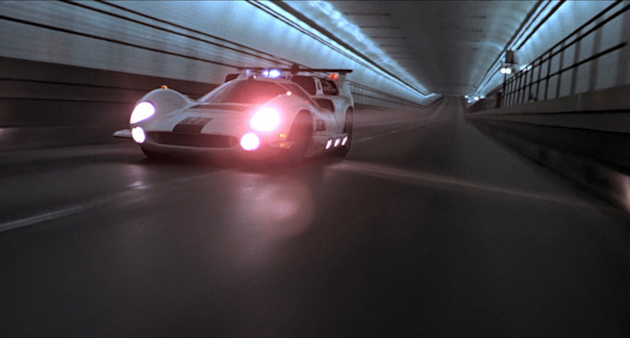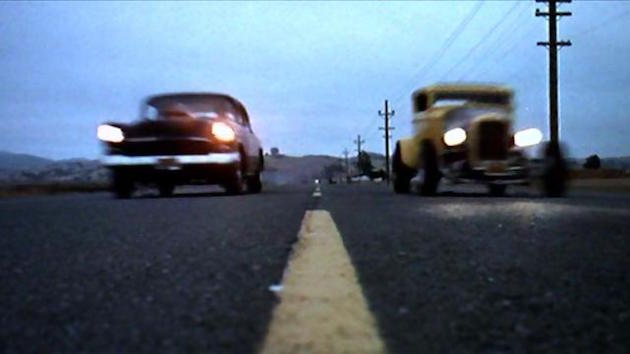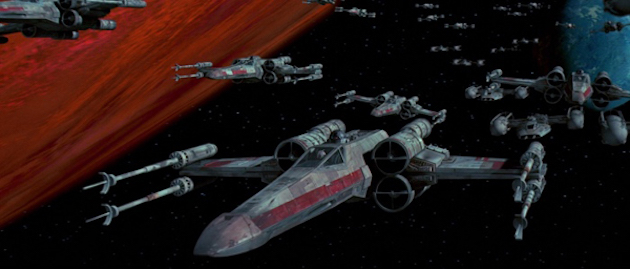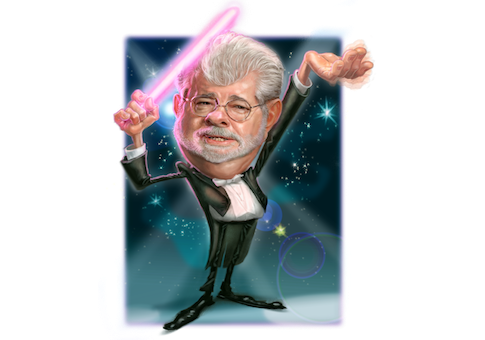In February 1977, George Lucas screened a rough cut of Star Wars for friends. Among the guests were filmmakers Willard Huyck and Gloria Katz, Matthew Robbins and Hal Barwood, Brian DePalma, and Steven Spielberg—the so-called movie brats.
They were not amused. DePalma was the harshest critic: He thought Lucas had wasted years of his life. Only Spielberg was wholly encouraging. "Steven said, ‘This is the greatest movie ever made, it’s going to make 100 million dollars!" Lucas recalled. But even he didn’t share his friend’s enthusiasm.
I think I know why. The cut the USC film gang watched wasn’t rough. It was defective. Most of the effects shots were incomplete. They were watching Peter Cushing spliced with documentary footage of World War II dogfights. And just as important as the missing imagery were the missing sounds.
Imagine watching Star Wars for the first time—but on mute. Wouldn’t work. You’d be depriving yourself of more than half the experience. Why? Because it’s the aural and tactile sensations that carry you away. Without the sound effects by Ben Burtt and the score by John Williams, it would be impossible for you to suspend disbelief.
It wasn’t until March 1977, two months before release, that the movie came together. On March 1, an unemployed actor was paid $7,500 for two and a half hours of voiceover recording in a Los Angeles studio. James Earl Jones received no credit. But his few lines, enhanced by Burtt’s effects, became indelible. Take a basso profundo, "worldize" it by recording the playback through regular speakers, add an iron lung—and you have the most awe-inspiring Hollywood monster since Frankenstein.
Then on March 5, in England, the London Symphony Orchestra began recording Williams’ score. Lucas was there to supervise. He was thrilled by the music. This was the first time he’d felt any excitement about the movie that had exhausted and demoralized him for the past four years. From the studio he placed a trans-Atlantic call to Spielberg so that the director, who had used Williams on Sugarland Express (1974) and Jaws (1975), could hear the various themes and fanfares for himself. Spielberg listened for 30 minutes.
So much of the writing about Star Wars is devoted to the look of the film: the storyboards, the models, the matte paintings, the makeup, the costumes, the differences between practical effects and digital ones. And the images are spectacular. But they are only half the equation. In some ways they are the less innovative half: spaceships and monsters and swordfights had a long cinematic history prior to Star Wars. The soundscapes Lucas orchestrated did not. Star Wars is not just a cinematic achievement. It’s a symphonic one.
Consider the famous opening scene. A blockade-runner zooms over our heads, followed by the gigantic Star Destroyer. Your typical Star Wars fan cites this moment as decisive in winning him over.
What makes these few minutes gripping? True, the model spaceships are much faster than their predecessors in 2001: A Space Odyssey (1968) and Silent Running (1972). But what moves us is the soundtrack: the brassy swells and thundery drums, the roar of the engines, the vibration that accompanies the Star Destroyer as it enters the frame, the thwack-thwack of turbo-lasers as the vessels exchange fire.
The relation between sound and image had been a preoccupation of Lucas’s since his time at USC. He noticed that the sounds of his movies would attract passerby who hadn’t seen a frame. Electronic Labyrinth (1967), the student film later remade professionally and distributed nationally as THX 1138 (1971), began a series of experiments in which soundtrack was given equal weight to photography.

"The sound montage," write Michael Pye and Linda Myles in The Movie Brats, "was an organic part of the film, not a decoration imposed afterward." What makes THX engrossing and unsettling is the ambient sound: disconnected and distorted lines of dialogue, muffled voices over transistor radios, the howl of police motorcycles, the wispy pleas of a metallic policeman echoing in a missile shaft.
Lucas continued to treat audio elements as significantly as visual ones in American Graffiti (1973). He wrote the screenplay for this nostalgic look at the car-culture of his high-school years while listening to old 45-rpm records, and matched scenes to specific songs. The sound was to be both naturalistic and immersive. It would transport the audience to 1962. Lucas experimented with recording techniques to heighten the realism. "We made a score in sound effects," editor Walter Murch said later.
American Graffiti was an unexpected blockbuster. The studio asked for a sequel. Lucas agreed to produce one—on the condition he be allowed to remix the original in stereo. "There is complex crosscutting between speakers at the front and back of the cinema as well as from side to side," write Pye and Myles of the re-released picture. "The effect is stronger. If you remember, we lived with the radio on; music frames and counterpoints the action." Which is exactly what Lucas wanted.

Star Wars took his experiments to a higher level. The task of the sound editors was not to create a dystopia like in THX or recreate the Modesto, California, of the early ’60s like in American Graffiti. It was to populate an utterly fantastic galaxy with convincingly naturalistic sounds. Film scholar Will Brooker describes how Ben Burtt
carried his Nagra tape recorder around the Los Angeles Zoo, LAX, military bases, and his own apartment, composing a ‘sound fabric’ for Star Wars. He mixed the sound of takeoffs, rifle ranges, and strafing runs into an armory of sounds for the Rebel and Imperial war machines, created Chewbacca’s speech from a cinnamon bear, a walrus, seal, and badger, and developed the threatening buzz of light sabers from, fittingly, the static of a TV set and the motor a film projector.
Buffs love this sort of trivia. The scream of a TIE fighter, one learns from Making Star Wars by J.W. Rinzler, is "an elephant howling slowed down and stretched out electronically." More striking than these details, however, is the sheer number of memorable effects: the vocalizations of R2-D2, the alien languages of the Jawas, the Tusken raiders, and of Greedo, the chirps and gongs of droids, the muted voices of storm troopers, the background hum of the space station, the reverberating Death Star super laser, the buzz of the jungle on Yavin IV.
Atop these unusual-yet-familiar noises is the most stirring film score ever. The almost continuous music adds depth to the film, communicating shifts in emotion and tone more effectively than the dialogue or performances. It’s not Mark Hamill we respond to when Luke Skywalker gazes into the binary sunset of Tatooine but the theme Williams composed for Hamill; it’s not Carrie Fisher’s line "They’re coming through!" that builds tension before Princess Leia and Luke swing across the Death Star chasm, but Williams’s strings and brass and drums.
Indeed, so significant is Williams’s contribution to Star Wars that it singlehandedly undermines the auteur theory of directorial primacy. All Lucas did, after all, was hire the composer. He was as captive to the man’s genius as the rest of us.

The image and sound and music achieve their most visceral and transporting effects during scenes where objects travel at high speed. Think about the attack on the Death Star, specifically the moments beginning when Peter Cushing as Grand Moff Tarkin says, "You may fire when ready": the Doppler-effect of TIE fighters and X-Wings in the trench, the reverberating lasers, and the timpani suddenly giving way to a harp glissando—this is a distillation of why Star Wars succeeds, how it created a pattern followed (not always successfully) by action directors for decades.
A car nut, Lucas has always been fascinated in the portrayal of vehicles on film. He’s attracted to their surfaces, their dynamism, their roar, the velocity at which they enter and exit the frame. THX, American Graffiti, and Star Wars IV, VI, I, II each feature gassed-up pursuits, and it sometimes feels as though Lucas is fine-tuning the same basic sequence over and over, fiddling with the details, seeing if he can’t make the cuts quicker, the engines louder, the music more emphatic, the gee-whiz feeling more intense.
It’s in these scenes where Lucas demonstrates most vividly his novel approaches to the layering of sound and image. And it’s the audio tracks of these scenes—the sounds of TIE fighters, blasters, lightsabers, the Millennium Falcon jumping into light speed, Luke Skywalker’s fanfare, and the Imperial March—that little kids mimic long after the movie has finished (not that I’d know anything about that). It’s not the story or special effects that makes Star Wars great. It’s the sounds.
